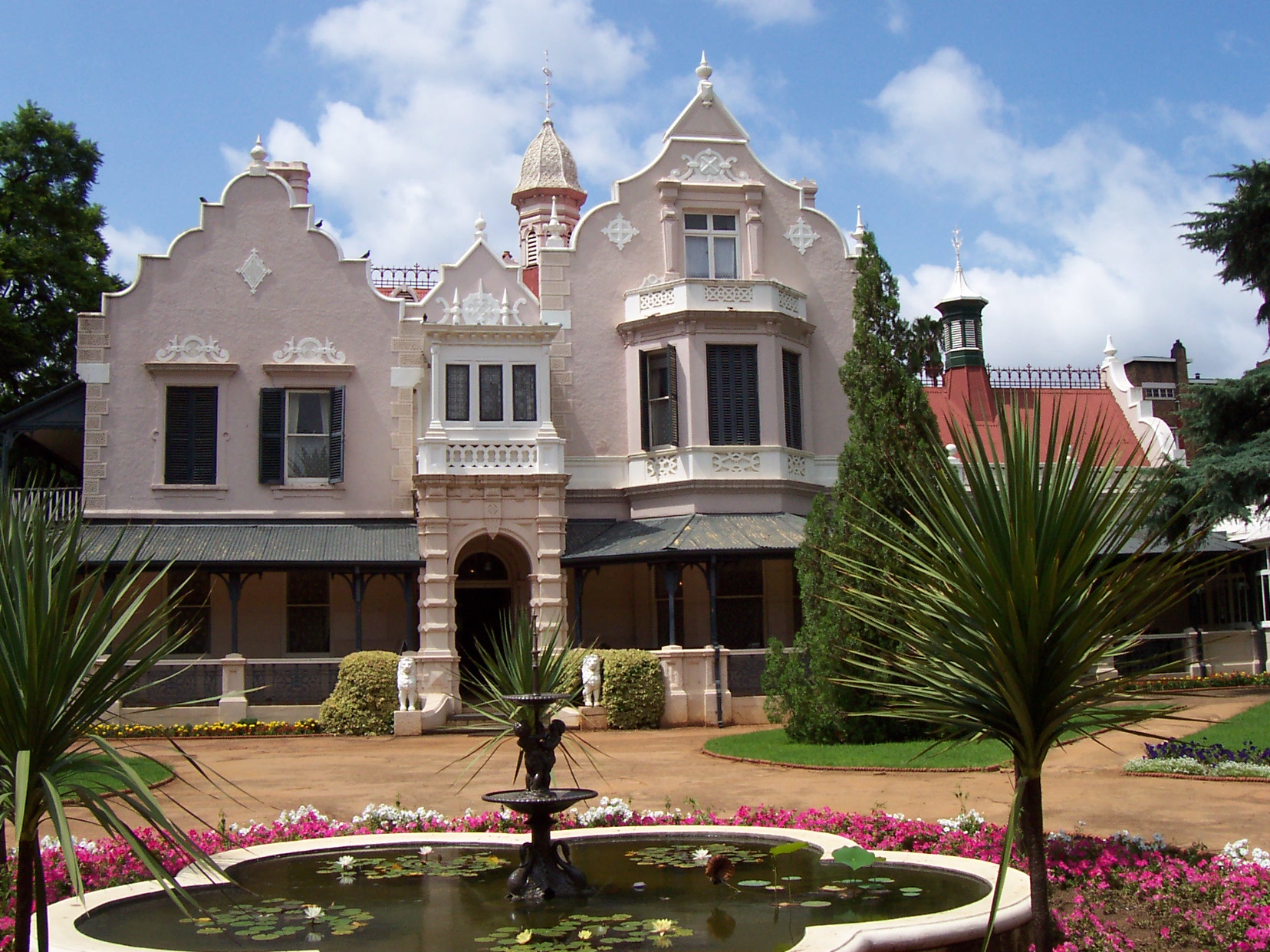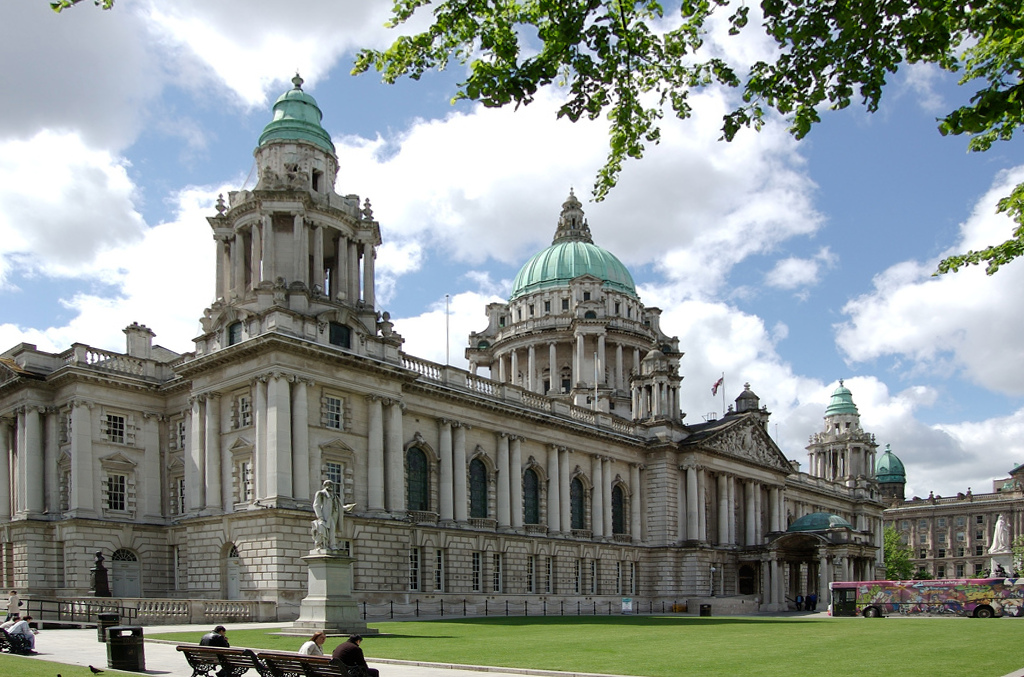|
Melrose House
Melrose House is a stately mansion and museum located opposite Burgers Park in Pretoria, South Africa. History Built in 1886 by the prosperous Pretoria businessman George Jesse Heys, it was named after the famous Melrose Abbey in Scotland. Melrose House gained fame during the Second Boer War (1899–1902) when Frederick Roberts, 1st Earl Roberts, Lord Roberts requisitioned it as the headquarters for the United Kingdom, British forces after Pretoria was invaded in June 1900. For more than 18 months, instructions for the British forces in the field were issued from here. The use of the house as a military headquarters ended when the Treaty of Vereeniging, which ended the war, was signed there on 31 May 1902. The City of Tshwane, Pretoria City Council purchased the house and its contents in 1967 for R300,000 for restoration, culminating in State President of South Africa Charles Robberts Swart opening it as a museum and declaring it a national heritage site on May 17, 1971. M ... [...More Info...] [...Related Items...] OR: [Wikipedia] [Google] [Baidu] [Amazon] |
Mansion
A mansion is a large dwelling house. The word itself derives through Old French from the Latin word ''mansio'' "dwelling", an abstract noun derived from the verb ''manere'' "to dwell". The English word ''manse'' originally defined a property large enough for the parish priest to maintain himself, but a mansion is usually no longer self-sustaining in this way (compare a Roman or medieval villa). ''Manor house, Manor'' comes from the same root—territorial holdings granted to a lord who would "remain" there. Following the fall of Rome, the practice of building unfortified villas ceased. Today, the oldest inhabited mansions around the world usually began their existence as fortified houses in the Middle Ages. As social conditions slowly changed and stabilized fortifications were able to be reduced, and over the centuries gave way to comfort. It became fashionable and possible for homes to be beautiful rather than grim and forbidding allowing for the development of the modern mansi ... [...More Info...] [...Related Items...] OR: [Wikipedia] [Google] [Baidu] [Amazon] |
City Of Tshwane
The City of Tshwane Metropolitan Municipality (; ; ), also known as the City of Tshwane (), is the metropolitan municipality that forms the local government of northern Gauteng in South Africa. The metropolitan area is centred on the city of Pretoria with surrounding towns and localities included in the local government area. History The City of Tshwane Metropolitan Municipality was established on 5 December 2000, comprising 13 former city and town councils and managed under an executive mayoral system. The Metsweding District Municipality was incorporated into the municipality with effect from 18 May 2011 (the date of the 2011 municipal elections). Geography The City of Tshwane Metropolitan Municipality's land area increased from in 2010 to after the incorporation of Metsweding, making it the largest Metropolitan Municipality in South Africa. The Tswaing crater is in the northwest of Soshanguve. Constituent areas The City of Tshwane Metropolitan Municipality consists ... [...More Info...] [...Related Items...] OR: [Wikipedia] [Google] [Baidu] [Amazon] |
Historic House Museums In South Africa
History is the systematic study of the past, focusing primarily on the human past. As an academic discipline, it analyses and interprets evidence to construct narratives about what happened and explain why it happened. Some theorists categorize history as a social science, while others see it as part of the humanities or consider it a hybrid discipline. Similar debates surround the purpose of history—for example, whether its main aim is theoretical, to uncover the truth, or practical, to learn lessons from the past. In a more general sense, the term ''history'' refers not to an academic field but to the past itself, times in the past, or to individual texts about the past. Historical research relies on primary and secondary sources to reconstruct past events and validate interpretations. Source criticism is used to evaluate these sources, assessing their authenticity, content, and reliability. Historians strive to integrate the perspectives of several sources to develop ... [...More Info...] [...Related Items...] OR: [Wikipedia] [Google] [Baidu] [Amazon] |
Houses Completed In 1886
A house is a single-unit residential building. It may range in complexity from a rudimentary hut to a complex structure of wood, masonry, concrete or other material, outfitted with plumbing, electrical, and heating, ventilation, and air conditioning systems.Schoenauer, Norbert (2000). ''6,000 Years of Housing'' (rev. ed.) (New York: W.W. Norton & Company). Houses use a range of different roofing systems to keep precipitation such as rain from getting into the dwelling space. Houses generally have doors or locks to secure the dwelling space and protect its inhabitants and contents from burglars or other trespassers. Most conventional modern houses in Western cultures will contain one or more bedrooms and bathrooms, a kitchen or cooking area, and a living room. A house may have a separate dining room, or the eating area may be integrated into the kitchen or another room. Some large houses in North America have a recreation room. In traditional agriculture-oriented societies, domes ... [...More Info...] [...Related Items...] OR: [Wikipedia] [Google] [Baidu] [Amazon] |
Museums In Pretoria
A museum is an institution dedicated to displaying or preserving culturally or scientifically significant objects. Many museums have exhibitions of these objects on public display, and some have private collections that are used by researchers and specialists. Museums host a much wider range of objects than a library, and they usually focus on a specific theme, such as the arts, science, natural history or local history. Public museums that host exhibitions and interactive demonstrations are often tourist attractions, and many draw large numbers of visitors from outside of their host country, with the most visited museums in the world attracting millions of visitors annually. Since the establishment of the earliest known museum in ancient times, museums have been associated with academia and the preservation of rare items. Museums originated as private collections of interesting items, and not until much later did the emphasis on educating the public take root. Etymology The ... [...More Info...] [...Related Items...] OR: [Wikipedia] [Google] [Baidu] [Amazon] |
Porcelain
Porcelain (), also called china, is a ceramic material made by heating Industrial mineral, raw materials, generally including kaolinite, in a kiln to temperatures between . The greater strength and translucence of porcelain, relative to other types of pottery, arise mainly from Vitrification#Ceramics, vitrification and the formation of the mineral mullite within the body at these high temperatures. End applications include tableware, ceramic art, decorative ware such as figurines, and products in technology and industry such as Insulator (electricity), electrical insulators and laboratory ware. The manufacturing process used for porcelain is similar to that used for earthenware and stoneware, the two other main types of pottery, although it can be more challenging to produce. It has usually been regarded as the most prestigious type of pottery due to its delicacy, strength, and high degree of whiteness. It is frequently both glazed and decorated. Though definitions vary, po ... [...More Info...] [...Related Items...] OR: [Wikipedia] [Google] [Baidu] [Amazon] |
Stained Glass
Stained glass refers to coloured glass as a material or art and architectural works created from it. Although it is traditionally made in flat panels and used as windows, the creations of modern stained glass artists also include three-dimensional structures and sculpture. Modern vernacular usage has often extended the term "stained glass" to include domestic leadlight, lead light and ''objet d'art, objets d'art'' created from glasswork, for example in the famous lamps of Louis Comfort Tiffany. As a material ''stained glass'' is glass that has been coloured by adding Salt (chemistry), metallic salts during its manufacture. It may then be further decorated in various ways. The coloured glass may be crafted into a stained-glass window, say, in which small pieces of glass are arranged to form patterns or pictures, held together (traditionally) by strips of lead, called cames or calms, and supported by a rigid frame. Painted details and yellow-coloured Silver staining, silver stain ... [...More Info...] [...Related Items...] OR: [Wikipedia] [Google] [Baidu] [Amazon] |
Architectural Style
An architectural style is a classification of buildings (and nonbuilding structures) based on a set of characteristics and features, including overall appearance, arrangement of the components, method of construction, building materials used, form (architecture), form, size, structural design, and regional character. Architectural styles are frequently associated with a historical epoch (Renaissance style), geographical location (Italian Villa style), or an earlier architectural style (Neo-Gothic style), and are influenced by the corresponding broader Style (visual arts), artistic style and the "general human condition". Heinrich Wölfflin even declared an analogy between a building and a costume: an "architectural style reflects the ''attitude and the movement of people'' in the period concerned". The 21st century construction uses a multitude of styles that are sometimes lumped together as a "contemporary architecture" based on the common trait of extreme reliance on computer-a ... [...More Info...] [...Related Items...] OR: [Wikipedia] [Google] [Baidu] [Amazon] |
Edwardian Architecture
Edwardian architecture usually refers to a Baroque Revival architecture, Neo-Baroque architectural style that was popular for public buildings in the British Empire during the Edwardian era (1901–1910). Architecture up to 1914 is commonly included in this style. It can also be used to mean various styles in middle-class housing, including relaxed versions of Arts and Crafts architecture. Description Edwardian architecture is generally less ornate than high or late Victorian architecture, apart from a subset – used for major buildings – known as Edwardian Baroque architecture. The Victorian Society campaigns to preserve architecture built between 1837 and 1914, and so includes Edwardian as well as Victorian architecture within its remit. Characteristics The characteristic features of the Edwardian Baroque style were drawn from two main sources: the architecture of France during the 18th century and that of Sir Christopher Wren in England during the 17th—part of the E ... [...More Info...] [...Related Items...] OR: [Wikipedia] [Google] [Baidu] [Amazon] |
Historic House Museum
A historic house museum is a house of historic significance that is preserved as a museum. Historic furnishings may be displayed in a way that reflects their original placement and usage in a home. Historic house museums are held to a variety of standards, including those of the International Council of Museums. Houses are transformed into museums for a number of different reasons. For example, the homes of famous writers are frequently turned into writer's home museums to support literary tourism. About Historic house museums are sometimes known as a "memory museum", which is a term used to suggest that the museum contains a collection of the traces of memory of the people who once lived there. It is often made up of the inhabitants' belongings and objects – this approach is mostly concerned with authenticity. Some museums are organised around the person who lived there or the social role the house had. Other historic house museums may be partially or completely reconstruct ... [...More Info...] [...Related Items...] OR: [Wikipedia] [Google] [Baidu] [Amazon] |
Charles Robberts Swart
Charles Robberts Swart (5 December 1894 – 16 July 1982), nicknamed "Blackie", was a South African politician who served as the last governor-general of the Union of South Africa from 1959 to 1961 and the first state president of the Republic of South Africa from 1961 to 1967. Early life Swart was born on 5 December 1894 on the Morgenzon farm, in the Winburg district, part of the Boer republic of the Orange Free State (which became a British colony in 1902 and a province of the Union of South Africa in 1910).''Current Biography Yearbook'' H. W. Wilson Company, 1960, page 420 He was the third of six children, born to Hermanus Bernardus Swart (1866–1949) and Aletta Catharina Robberts (1871–1927). The Anglo-Boer War ( |









